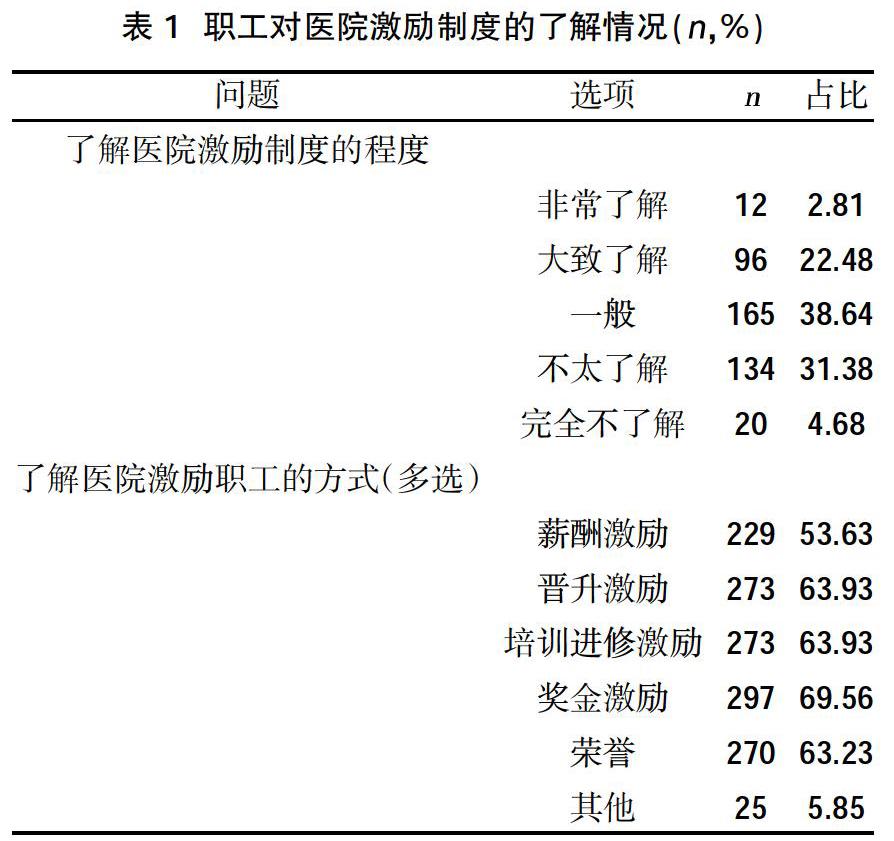复旦大学附属儿科医院职工学科评估导向优化激励政策的意愿分析及影响因素研究
陈霄雯,贾品,杨杪,钱莉玲,周文浩



摘要:目的 了解兒科医院职工对基于学科评估优化激励政策的意愿强弱,分析影响职工意愿的相关因素,为医院管理层制定相关激励政策提供参考依据。方法 于2019年3月~5月采用自制调查问卷以网络问卷的形式向我院职工推送调查问卷,调查医院激励机制的实施情况、职工对医院激励机制的满意情况,分析职工对学科评估导向的激励政策的意愿及其影响因素。结果 共回收有效问卷427份,涵盖了临床、护理、医技、行政管理等各类岗位,涉及共43个科室。约3/4的职工对医院的激励制度的了解程度在一般及以下。认为医院采取的激励措施效果比较好和非常好的占33.73%。医院职工对学科评估导向优化激励政策的整体意愿得分(3.62±0.75)分,介于“一般”与“愿意”之间,更靠近“愿意”。各二级维度中,调整带薪休假天数、调整医务人员数量、调整科研配套经费、调整研究生招生名额及分配进修交流名额这五项意愿得分高于平均意愿得分,差异有统计学意义(P<0.05);分配晋升名额、调整床位数量、年终科研奖励进行调整、对规/专培招录名额进行调整这四项意愿得分与平均意愿得分比较,差异无统计学意义(P>0.05);分配每月薪资、分配季度奖、分配年终奖三项意愿得分低于平均意愿得分,差异有统计学意义(P<0.05)。根据学科评估结果调整医院激励政策总体意愿(St)的影响因素有性别(女性>男性)、学历(大专及以下>硕士>本科>博士及以上)和工作岗位(其他>行政>护士>医技>医生)。结论 儿科医院职工对医院的激励机制还不是非常了解,医院应加强激励制度的宣传公告。医院采取的激励措施效果一般,但职工对学科评估导向优化激励政策表现出较强的意愿,管理层可优先考虑从调整带薪休假天数、调整医务人员数量、调整科研配套经费、调整研究生招生名额、分配进修交流名额等政策入手,调整优化激励政策方案。制定激励政策时,可根据不同对象分类制定,针对意愿较弱的人群,可加大激励力度,以充分调动每一类职工的主观能动性,推动学科发展。
关键词:儿科医院;激励政策;学科评估;意愿;影响因素
中图分类号:R197 文献标识码:A DOI:10.3969/j.issn.1006-1959.2019.22.024
文章编号:1006-1959(2019)22-0079-05
A Study on the Willingness to Optimize the Incentive Policy of Staff in Children's Hospital of Fudan University Based on Disciplirary Evaluation and Its Influencing Factors
CHEN Xiao-wen1,JIA Pin1,YANG Miao2,QIAN Li-ling1,ZHOU Wen-hao3
(1.Department of Scientific Research,Children's Hospital of Fudan University,Shanghai 201102,China;
2.Department of Integrated Affairs Management,National Children's Medical Center,
Children's Hospital of Fudan University,Shanghai 201102,China;
3.Department of Neonatology,Children's Hospital of Fudan University,Shanghai 201102,China)
Abstract:Objective To understand the willingness of employees in children's hospital of fudan university to optimize incentive policies based on disciplinary assessment, and to analyze the relevant factors affecting the will of employees, and to provide reference for hospital management to formulate relevant incentive policies.Methods From March to May 2019, using self-made questionnaires to send questionnaires to our staff in the form of online questionnaires, to investigate the implementation of hospital incentives, the satisfaction of employees on hospital incentives, and to analyze the orientation of employees' evaluation of disciplines. The willingness to encourage policies and its influencing factors.Results A total of 427 valid questionnaires were collected, covering various positions in clinical, nursing, medical technology, and administrative management, involving a total of 43 departments. About 3/4 of the employees have a general understanding of the hospital's incentive system in the general and below. It is believed that the incentive measures adopted by the hospital are relatively good and very good, accounting for 33.73%. The overall willingness of hospital staff to optimize the incentive policy for disciplinary assessment (3.62±0.75) is between "general" and "willing" and closer to "willingness". In each of the second-level dimensions, the five willingness scores of adjusting the number of paid vacation days, adjusting the number of medical staff, adjusting the funding for scientific research, adjusting the number of postgraduate enrollment and allocation of training exchange quotas are higher than the average willingness score,the difference was statistically significant (P<0.05); the assignment promotion quota, adjustment of the number of beds, year-end research awards adjustment, adjustment of the rules/special training quotas, the four willingness scores and the average willingness score,the difference was not statistically significant (P>0.05); the distribution of monthly salary, distribution quarterly award and allocation year-end award were lower than the average willingness score,the difference was statistically significant (P<0.05). According to the results of the disciplinary assessment, the overall influencing factors of the hospital incentive policy (St) are gender (female > male),education (College and below > Master's degree > Bachelor > Doctoral and above) and Jobs (Other > Executive > Nurse > Medical Technology > Doctor). Conclusion Pediatric hospital staff are not very aware of the hospital's incentive mechanism, and hospitals should strengthen the promotion and promotion of incentive systems. The incentive measures adopted by the hospital are not satisfactory, but the employees show a strong willingness to optimize the incentive policies for the discipline evaluation. The management can give priority to adjusting the number of paid vacation days, adjusting the number of medical personnel, adjusting the research supporting funds, and adjusting the graduate enrollment quota. We will allocate policies such as training exchange quotas and adjust and optimize incentive programs. When formulating incentive policies, they can be formulated according to different objects. For those with weak will, they can increase incentives to fully mobilize the subjective initiative of each type of employees and promote the development of disciplines.
Key words:Children's hospital;Incentive policy;Subject assessment;Willingness;Influencing factors
近年来,“儿科医护荒”的问题受到社会广泛关注。儿科医护人员相较其他医护人员职业风险更高、医患矛盾更突出,离职率居高不下等诸多问题也日趋凸现。在当今社会对儿科医护人员的迫切需求和亟需应对“患多医少”儿科医护人员超负荷工作的背景下,构建一套科学合理的儿科医护人员激励方案,采取行之有效的激励措施,已然成为当前的重要课题。为了充分了解儿科医院对职工的激励现状,探索以学科评估导向优化医院激励政策,引导学科资源配置,促进儿科医院学科发展,本研究选择我院职工为调研对象,于2019年3月~5月开展此次调查,现报告如下。
1对象与方法
1.1调查对象 以复旦大学附属儿科医院院内职工为调查总体,涵盖临床、护理、医技、行政管理等各类岗位,涉及共43个科室。调查样本人群总数427人,男女比例约1∶4,年龄21~58岁,平均年龄(32.82±7.19)岁。
1.2方法
1.2.1调查工具 本调查问卷“复旦大学附属儿科医院职工激励机制调查问卷”为自制调研问卷。问卷信度Cronbach's Alpha为0.961,效度KMO为0.927。问卷内容包括:受访者个人信息、医院激励机制相关情况、学科评估导向的激励政策意愿3个部分。核心板块为意愿调查板块,设置了非常不愿意、不愿意、一般、愿意及非常愿意5个档次,按照1~5计分。意愿调查共设置了4个一级维度,12个二级维度,分别为人事(每月薪资、季度奖、年终奖、休假、晋升)、临床医疗(床位数量、医护人员数量)、科研(配套经费、科研奖励)和教学(研究生招生名额、规/专培招录名额、进修/交流名额)。
1.2.2调查方法 调查表通过问卷星系统制成网络电子问卷,通过推送问卷二维码或者网络链接的形式经OA系统发送给院内职工,院内职工以微信登录后作答。数据通过问卷星系统自动收集,并导出成SPSS数据格式。
1.3统计学方法 运用SPSS 20.0分析软件进行数据统计分析,计量资料采用(x±s)表示,比较行配对t检验,计数资料采用(%)表示,比较行?字2或Z检验,激励政策意愿的影响因素分析用非参数秩和检验,检验水准α为0.05,P<0.05表示差异有统计学意义。
2结果
2.1基本情况 本调查共回收有效问卷427份,样本人群女性350人(81.98%),男女比例约1∶4,年龄35岁及以下295人(69.09%),已婚者271人(63.47%),未婚者148人(34.66%)。样本人群学历构成顺序前2位为本科(165人,38.63%)和硕士(100人,23.42%);所属专业中,医学(临床)类255人(59.72%);所属岗位中护士最多,202人(47.31%),医生129人(30.21%),医技73人(17.10%),其余还包括行政管理6人(1.41%)和其他17人(3.98%)。样本人群在医院的工作年限被纳入本次调查的个人信息中,按照新职工、老职工和稳定职工三类进行区分,其中稳定职工(≥10年)所占比例最高,为162人(37.94%),超过1/3,老职工(3~9年)所占比例第2,为144人(33.72%),约占1/3,新职工(0~3年)所占比例相对较低,为121人(28.34%)。样本人群中担任行政职务者29人(6.79%),其余398人(93.21%)均属于无行政职务的普通职工。
2.2医院激励机制现况
2.2.1职工对医院激励制度的了解情况 儿科医院职工对医院的激励机制还不是非常了解,74.70%的职工对医院的激励制度的了解程度在一般及以下;对于激励方式,半数以上的职工认为医院有通过奖金、晋升、培训进修、荣誉和薪酬这些方面对职工进行激励,见表1。
2.2.2职工对医院激励机制的满意情况 通过调查,儿科医院职工认为医院对职工采取的激励措施效果比较好和非常好的占33.73%,认为效果一般及以下的占66.28%;医院职工认为医院提供的发展机会比其他医院较好及以上的占42.86%,剩下的57.14%认为医院发展机会一般或者不如其他同级医院,见表2。
2.2.3职工对医院激励政策的建议 问卷的开放题“您对我院激励政策有何建议?”回收到有效答案共59条建议,其中关于涨薪的建议占13条,关于调整临床绩效考核,完善分配制度的建议占11条,关于减轻临床压力、增加休假的建议占8条,关于减轻科研压力的建议占7条,关于增加临床人员配备的建议占5条,关于优化晋升制度的建议占5条,关于增加进修培训的建议占5条,关于普及学科评估和激励制度的建议占3条,关于增加科研比重的建议占2条。
2.3学科评估导向的激励政策意愿
2.3.1职工学科评估導向的激励政策的意愿分析 职工平均意愿得分(3.62±0.75)分,介于“一般”与“愿意”之间,更靠近“愿意”。各二级维度中,调整带薪休假天数、调整医务人员数量、调整科研配套经费、调整研究生招生名额、分配进修、交流名额这五项意愿高于平均意愿得分,差异有统计学意义(P<0.05);分配晋升名额、调整床位数量、年终科研奖励进行调整、对规/专培招录名额进行调整这四项意愿与平均意愿得分比较,差异无统计学意义(P>0.05);分配每月薪资、分配季度奖、分配年终奖这三项意愿低于平均意愿得分,差异有统计学意义(P<0.05),见表3。
2.3.2学科评估导向的激励政策意愿影响因素分析 以性别、年龄、学历、最高学历对应的专业、工作岗位、工作年限、是否担任行政职务为自变量,以医院激励政策平均意愿为因变量,行秩和检验,结果显示医院激励政策平均意愿的影响因素有性别(女性>男性)、学历(大专及以下>硕士>本科>博士及以上)和工作岗位(其他>行政>护士>医技>医生),见表4。

